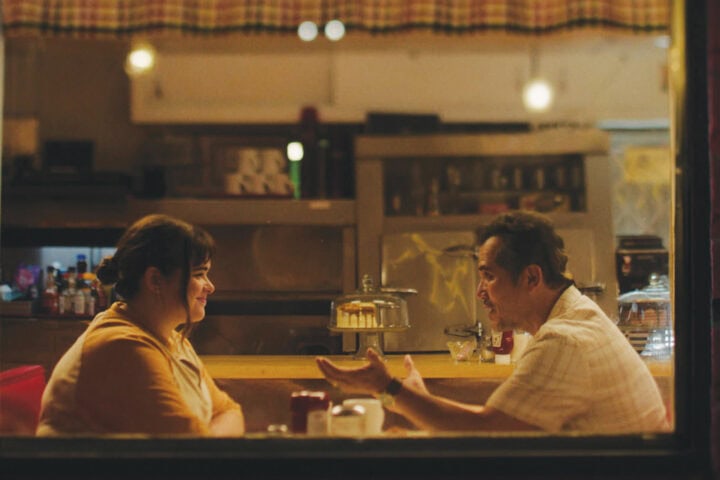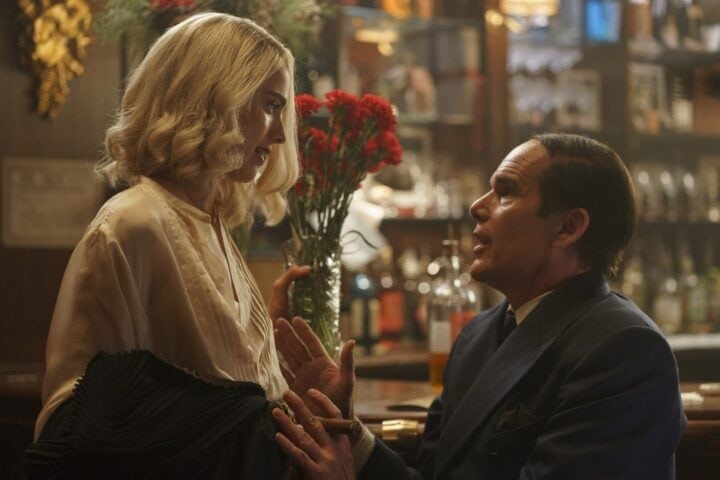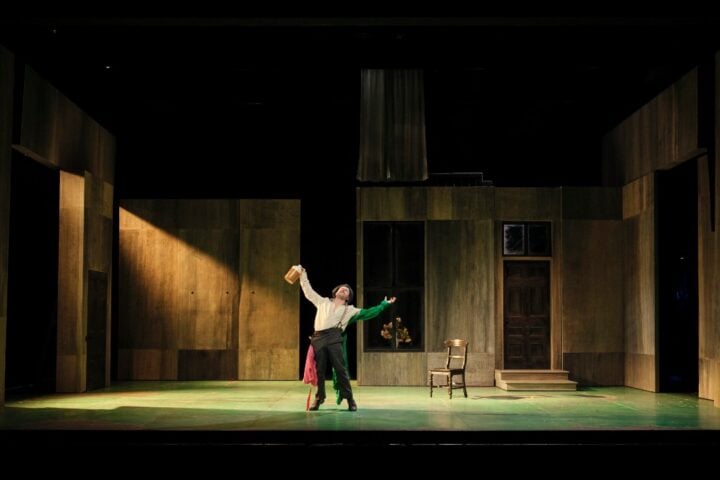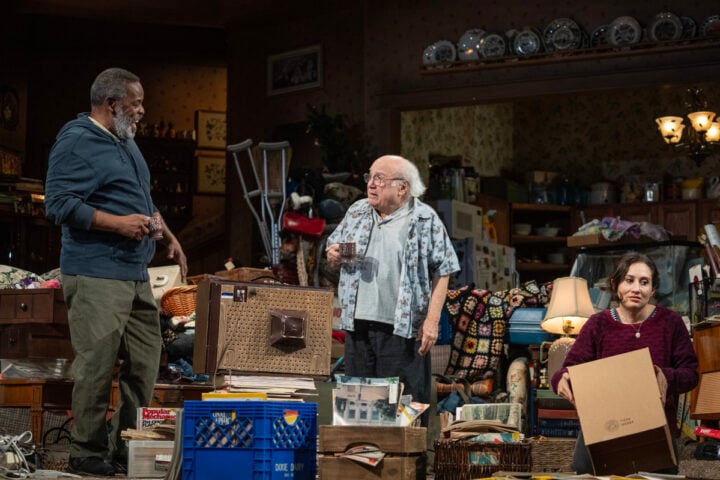“Sometimes people leave you halfway through the wood,” Cinderella sings in “No One Is Alone,” Stephen Sondheim’s clear-eyed reassurance of support and survival at the end of Into the Woods. Sondheim himself, who passed away in November 2021, left artistic companions, including book writer David Ives and director Joe Mantello, halfway through a wood they were constructing together: the musical Here We Are, now playing off-Broadway at the Shed’s Griffin Theater. With his final offering, Sondheim sends one last jolt of structural inventiveness coursing through the veins of the musical theater form. Here We Are may not operate on the grand scale of Sweeney Todd or Into the Woods or Follies, but it is, to quote the composer-lyricist, small and funny and fine.
Here We Are adapts two films by Luis Buñuel. The first act riffs on 1972’s The Discreet Charm of the Bourgeoisie. Ives borrows the basic premise of a wealthy group of friends thwarted from their meal again and again when they sit down to eat together but sheds the film’s inscrutable dream-within-a-dream structure. Ives’s characters, loosely inspired by Buñuel’s, instead travel from unsuitable restaurant to unsuitable restaurant over the course of a single day until they finally arrive at the home of the lothario-like Ambassador of Moranda (Steven Pasquale).
There, in the second act, the same characters enter the plot of an earlier Buñuel classic, 1962’s The Exterminating Angel: Having partied and dined in a lavish room together, the guests find that they can’t manage to leave. In Ives and Sondheim’s adaptation, the group in question centers around Marianne Brink (Rachel Bay Jones), who takes seriously her job of living lightly, of preserving the facade of her spotless life with Leo (Bobby Cannavale). Not for nothing does Marianne’s disgusted socialist sister, Fritz (Micaela Diamond), describe her as “pastel cast-iron.” These are the type of people who clone their dogs so that they can have identical sets of dogs at each of their homes (“They’re all real. Even the copies,” Marianne insists).
And though Fritz is in deep with revolutionaries plotting to bring about the end of the world and Leo and his pals are heading a cocaine ring, the gang’s biggest problems come in the face of a delayed brunch: first due to a waiter (Denis O’Hare) who confesses that Café Everything is out of, well, everything; then a hostess (Tracie Bennett) whose restaurant is keeping vigil over a corpse; and then a colonel (Francois Battiste) on a hunt for the drug cartel.
Here We Are never approaches the unsettling, almost vertiginous quality of either film, and that’s partly Sondheim’s fault: While Buñuel keeps us at an icy distance from his characters, who tend to blend together, the music lets us in with glittering specificity, even if the songs seldom explore anyone’s interiority. And because some of the most absurdist dream elements of The Discreet Charm of the Bourgeoisie—like a scene in which the dinner guests realize they’re on stage being watched by an audience—now take place not in a dream but in the waking world, the first act takes on a more whimsical and wacky, less queasily threatening tone. In other words, if it’s all supposed to be real, then none of it’s realistic enough to be scary.
Here We Are isn’t unnerving in the spine-crawling way that The Exterminating Angel and The Discreet Charm of the Bourgeoisie are (for more faithfully terrifying music, listen to Thomas Adès’s seething operatic adaptation of the former, which premiered in 2016). But the show still moves from a frothily weird and wonderful first act to an opaquely heartbreaking second act that—as has been widely reported—offers almost no music at all.
What music there is, though, doesn’t disappoint. Sondheim’s score is decidedly within his most familiar vocabulary, a final master class in pressing music into the service of character. As the recent revivals of Sweeney Todd and Merrily We Roll Along also demonstrate, one of Sondheim’s superior gifts was his impeccable understanding of how the ear processes language. Rhythm and melody, under his pen, allow the text to crash like a wave over us, somehow guiding the listener response so that everyone gets the joke at the exact same moment. There’s something irreplaceable in being part of an audience experiencing a lyric like O’Hare’s frenzied waiter’s “We do expect a little latte later/But we haven’t got a lotta latte now” for the first time.
And because the scenario seems to hold these characters, at least for the first act, in a sort of satirical contempt, that frees Sondheim, who was so frequently accustomed to injecting irony into many a dissonant chord and slightly caustic melody, to write with often unadulterated warmth and buoyancy. And the cast, especially Jones and O’Hare, approach the songs with sublime clarity, turning over the text as if closely examining a strange stone found on a beach. (In the wide space of the Shed, the sound design, though, occasionally allows the orchestra to drown out the sung text.) A soaring tenor ballad for a soldier (Jin Ha), joined later in duet by the delightful Diamond, has the greatest shot at entering the audition book and cabaret canon.
That, though, couldn’t be farther from the goals of Sondheim’s most jagged score, in which songs sometimes stumble from, and recede back into, Ives’s book, sometimes without finishing or even fully getting started. That’s not to say that Here We Are’s songs—or the show itself—feel unfinished. More so than in any of his previous partnerships, it’s hard to tell exactly where Sondheim leaves off and his book writer takes over. The first act, then, is a marvel of collaboration, a convincing marriage of shared—strange and silly but always shared—vision.
As for the second act, Sondheim’s chief surviving collaborators, Ives and Mantello, maintain that the idea for music to vanish in the second act derived not from Sondheim’s death but from his writer’s block and procrastination. He had agreed that he had completed the lion’s share of his contribution to the work and that Ives would complete the largely song-free second act.
The concept for Ives’s adaptation of The Exterminating Angel is that, while trapped within the room, the characters lose the ability to sing. Even the on-stage piano stops making sound about 20 minutes into the second act, with Sondheim’s loss a poignant paratext: “Rest in peace,” intones a bishop (David Hyde Pierce) when he discovers that the instrument has fallen silent. Since we’ve met the characters in music, their silence is a little sad, but Ives’s dialogue moves the characters through the fraught second act with greater momentum than songs, even Sondheim’s, might allow. It’s not hard to imagine why The Exterminating Angel’s oppressive structure would have gotten Sondheim, an infamous procrastinator, so stuck.
While the device of characters losing song is effective, it could be signaled a little more intentionally or overtly. It’s a little confusing that robust instrumental transitions continue throughout Here We Are’s second act, glorious as Jonathan Tunick’s final orchestrations for Sondheim’s music (a collaboration also currently represented in both Sondheim revivals on Broadway) may be: If the piano can’t make music when the characters are trapped in the room, why can the strings section? (The only sounds in Buñuel’s two films, by the way, are strictly diegetic, their footstep-heavy soundscapes often claustrophobically dry.)
In David Zinn’s set, the initial austerity winkingly transforms into excess, but the show also sits a bit uncomfortably in its contemporary setting, as there’s something about the slick attitudes of its characters that seems to live still in the late-’70s or early-’80s vernacular of Sunday in the Park with George’s second act or Merrily We Roll Along’s opening scenes. It’s strange, too, to see Sondheim setting the rhythms of cellphone conversations in his only score set in the 21st century. When Fritz the millennial revolutionary sings, “They’re gonna blow your mergers/And your laptops/And your bitcoins/All to bits,” as if only capitalists use the internet, there’s a slight whiff of Sondheim approximating the buzzwords of a generation he hadn’t fully understood.
But by placing Here We Are in the present moment, Ives also allows us to make present meaning out of the show. Throughout the second act, characters step up to what the script calls the “portal” of the room and find themselves unable to leave. The text makes no indication of why they cannot do so, and the characters never describe what they experience at that threshold, but Mantello’s staging speaks volumes: When they approach the “portal,” they seem to see something that keeps them inside, even to their own detriment, even if they want to depart.
Mantello transposes terror that hovers in the air in The Exterminating Angel to the eyes of his actors as they gaze beyond the room. What might they see out in the real world that would make them feel that they have no choice but to stay where they are, even as they begin to starve? Watching Here We Are in the fall of 2023, imagining the violence and horror they’re so desperate to avoid confronting, it’s easy to picture one way to fill in the blanks.
While the characters, for the most part, are too embedded in their way of life to become anyone new, Jones’s Marianne makes a quiet, bold attempt to extend her worldview beyond herself, especially in a lovely, bizarre scene with Pierce’s priest, who’s resorted to eating pages of A Tale of Two Cities once the food runs out. “Why can’t I be free/To like what I see/And not what I know?” Marianne sings early in the second act, shortly before the music goes out. It’s a plea for blissful ignorance, a desire to live only in the limited reality that the prosperous and the safe can create for themselves. Her subtle shift toward choosing to recognize reality—even if she doesn’t quite know how to combat her naïveté—is the show’s loveliest, most affecting gesture.
Would Here We Are register as quite so startlingly moving if Sondheim were still alive? Quite possibly not, but theater is always a living art form, each performance’s impact reflective of the moment in which the audience receives it. Here We Are, integrated into the Sondheim canon a decade from now, may lose some of its potency. (The sudden success of Merrily We Roll Along, once a cold-blooded flop but now enjoying a sold-out, emotionally devastating Broadway revival, demonstrates that Sondheim’s works have taken unpredictable journeys in popular reception.) If much of the immediate pleasure in Here We Are derives from the extra-textual experience of watching a new, rich Sondheim show, that doesn’t make the pleasure any less real.
“So, old friends, now it’s trying to start growing up,” Sondheim wrote in Merrily We Roll Along. “Taking charge, seeing things as they are.” Even though Here We Are’s characters will not step up to the threshold to peer beyond the world they’ve built for themselves, that doesn’t mean we can’t. If Sondheim’s ouevre was always all about awakening—from fairy-tale characters learning to live in reality to aging Broadway babies learning to live in the present and 35-year-old bachelors learning how to live fully in their own lives—Here We Are is one last invitation to let Sondheim’s music guide us through the woods as he teaches us to see things as they are.
Here We Are runs through January 21 at the Shed.
Since 2001, we've brought you uncompromising, candid takes on the world of film, music, television, video games, theater, and more. Independently owned and operated publications like Slant have been hit hard in recent years, but we’re committed to keeping our content free and accessible—meaning no paywalls or fees.
If you like what we do, please consider subscribing to our Patreon or making a donation.






